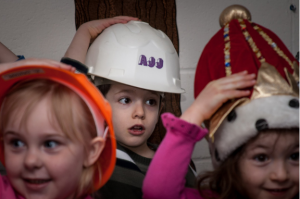Promoting Family Engagement in the Early Learning Classroom
What does this look like in a early learning classroom? Embracing each child’s family will enhance their partnership in the classroom. A family is made up of the people that care for the child, which can mean a variety of family structures. The first step of family engagement is accepting families as they come to us.
In this new year and with new families,these are some of the ways our SLOCOE Early Learning Centers use to help families feel welcome in the program. When families feel welcomed they will become more engaged.
- Get to Know Your Families
Acceptance of a child’s family helps create social and emotional well being. It is important for teaching staff to gain an understanding of who their families are. What constitutes a family varies. What is the child’s home culture, what is important to them as a family within their home environment and how should or can those cultural norms transfer to the child’s classroom? Understanding a child’s home culture can help create a smoother transition into the early learning classroom by providing a degree of familiarity and comfort for the parents and child.“If children feel safe, they can take risks, ask questions, make mistakes, learn to trust, share their feelings, and grow.” ~ Alfie KohnThe same can hold true for parents…  Communication is Vital
Communication is Vital
Is it a daily message log, an email group for the families, classroom blog, or a private classroom website. Connecting with families throughout the day starts the vital home – school connection. If your communications engage parents you will build a stronger partnership between teacher and family. This will lead to a better understanding of the child, more feedback from parents and ultimately a happier successful learning experience for the child.Sharing photos, program reminders and daily activities helps families to feel connected to their child’s learning. It is also important to share who are the teachers educating their child, what is their background and their interests. Make connections with the teaching staff and the families.- Orientations and Family – Teacher Conferences
These opportunities allow for time set aside for just that family to get to know the program and share goals for their child both in the classroom and at home. Programs and families benefit by sharing resources and information. Teachers that share the reasons behind activities in the classroom help the parents better understand the value of those activities and will encourage them to continue the activity or skill at home.Conferences should be a 2 way conversation with both parties sharing where the child is in all areas of development (socially, academically, with language acquisition and with small and large motor skills) and then set attainable goals together to build on for the remainder of the school year. - Parent Meetings
Survey your parent group, plan parent meetings at the times where most parents can attend. Choose guest speakers that are of interest to the group. Share a meal, food always bring people together.Experts see “parent engagement in early education as one of the most powerful drivers of better educational outcomes for the future.”Nancy Norton
Director of Early Learning
Educational Support Services Department
San Luis Obispo County Office of Education
nnorton@slocoe.org
805-782-7274
Contact
- San Luis Obispo County Office of Education
- Office of James J. Brescia, Ed.D.
- 3350 Education Drive
- San Luis Obispo, CA 93405
- Tel: 805-543-7732
- Contact SLOCOE
- Contact Webmaster

